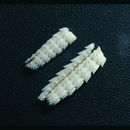en
names in breadcrumbs


No special status.
US Federal List: no special status
CITES: no special status
IUCN Red List of Threatened Species: endangered
This fish causes tremendous damage when packs of them become entangled in commercial fishing nets.
This species is used for its oil and as fish meal. It is also a popular labratory animal. In some areas (Europe more than the U.S.), it is a popular food fish.
Spiny dogfish prey on bony fishes, smaller sharks, octopuses, squid, crabs, and eggcases of sharks and chimaeras.
The spiny dogfish inhabits the temperate and subarctic latitudes of the North Atlantic and North Pacific oceans. Specimens have been found in the Black and Mediterranean seas.
Biogeographic Regions: arctic ocean (Native ); atlantic ocean (Native ); pacific ocean (Native )
Spiny dogfish exist in an oceanic environment of depths from the surface to 400 fathoms or more. They prefer a temperature range of 6-11 degrees centregade.
Aquatic Biomes: benthic ; coastal
Average lifespan
Status: wild: 60.0 years.
The spiny dogfish can be recognized by its two dorsal fins, each with a spine; second dorsal is smaller than the first. Pectoral fins posses curved margins and rounded free rear tips. These sharks have narrow anterior nasal flaps. The teeth are oblique and smooth with a notch on the outer margin. Color is slate grey to brown above (often with scattered small white spots) and light grey to pure white on the belly. An albino was reported in Norwegian waters.
Range mass: 3.1 to 9.1 kg.
Other Physical Features: bilateral symmetry
This shark is ovoviviparous. Males reach maturity between 80-100cm in length or at around 11 years of age; females mature at100-124 cm or in 18-21 years. Mating takes place during the winter months. As soon as the eggs are fertilized, the female secretes a thin, horny, transparent shell around them. The shells suround several eggs at once and are called candles. Gestation lasts between 22-24 months. Litters range between 2-11 pups and are between 20-30 cm at birth. They live for as long as 25-30 years.
Average age at sexual or reproductive maturity (male)
Sex: male: 3163 days.
Average age at sexual or reproductive maturity (female)
Sex: female: 7668 days.